Theory of Development (1) Harrod-Domar Growth Model
Theoretical Development models do not appear on the syllabus
anymore but you should have at least some idea of the 2 main theories
(see also Pages 89 and 90)
Harrod-Domar Growth Model
The Harrod-Domar model is unsurprisingly named after two economists,
RF Harrod and ED Domar, who were working in the l930s. The model
suggests that the economy's rate of growth depends on:
- The level of saving
- The productivity of investment, i.e. the capital output ratio
They placed considerable emphasis on investment, savings and
technology as the main agents of economic growth. Increased investment
forces the production possibility curve outwards and create more
wealth. The impact of this increased investment on the production
possibility frontier is shown in Figure 1 below.

Figure 1 Increased investment shifting the production possibility frontier
The model concludes that:
- Increasing the savings ratio, and/or the amount of investment
and/or the rate of technological progress are vital for the growth
process
- Economic growth depends on the quantity and quality of labour and capital.
- As developing countries often have an abundant supply of labour
(however it neglects the quality of the labour so the conclusion is
questionable), it
is a lack of physical capital that holds back economic growth and
development.
- More physical capital (real investment) generates economic growth.
- Net investment leads to more capital accumulation, which generates higher output and income.
- Higher income allows higher levels of saving and so on...
The key to economic growth is therefore to expand the level of
investment, both in terms of fixed capital and human capital. To do
this, policies are needed that encourage saving and/or generate
technological advances enabling firms to produce more output with less
capital, i.e. lower their capital output ratio.
The model has been criticised for focusing on economic growth. Problems with the approach include:
- Economic growth and economic development are not the same. Economic
growth is a necessary, but not sufficient, condition for development
- Savings and investment are a necessary, but not sufficient, condition for development
- On a practical level, it is difficult to stimulate the level of
domestic savings, particularly in the case of developing countries
where incomes are low.
- Borrowing from overseas to fill the gap caused by insufficient savings causes debt repayment problems later (see Section 4.7)
- The law of diminishing returns would suggest, that as investment
increases, the growth of the productivity of capital will diminish and the capital to
output ratio will therefore rise (more capital needed to achieve given increases in output)
|